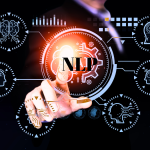Natural language processing (NLP) works like computer magic, allowing machines to understand and chat with us. Think of it as a bridge between how we naturally talk and how computers work. You know those helpful chatbots on websites that respond like good friends? NLP powers them.
But NLP isn’t just for websites. It’s the reason search engines like Google and Microsoft Bing now “get” us better. Instead of typing in full, you can ask a question, and thanks to NLP, the search engine figures out exactly what you need.
In tech speak, NLP is a part of artificial intelligence (AI) that focuses on how computers and human language interact. It means teaching computers to speak our language!
Table of Contents
Terms used in Natural Language Processing
These terms are often used while developing NLP applications or explaining the way they work. You will notice that some of them are similar in terms of purpose and end goal.
- Tokenisation: The process involves breaking down text into smaller units called tokens, a crucial step in NLP that facilitates the deconstruction of language into manageable fragments. This aids subsequent analyses of word frequency and distribution.
Read also: An insightful guide to tokenomics in the blockchain industry
- Part-of-Speech (POS): This assigns grammatical categories, like nouns and verbs, to each word in a sentence, as the name implies. It provides syntactic information that is invaluable for understanding grammatical structure and extracting meaning from a wall of text.
- Named entity recognition (NER): This involves identifying and classifying entities, including names of people, organisations, and locations. This capability is essential for extracting specific information from large text data, like the find feature in a Word document or even using a keyword to find a webpage on search engines.
- Stemming and lemmatization: Both terms involve reducing words to their core forms. Stemming trims words to their roots, while lemmatization brings them to their base or dictionary form. These processes contribute to text analysis by making it easy to understand word variations and determine the emotions behind a text.
- Word embeddings: Word embeddings transform words into vectors in a multi-dimensional space, simplifying how a machine interprets words with the same meaning.
- Syntax and parsing: This delves into sentence structure, aiding tasks like understanding, grammar checking, and translation.
- Bag-of-Words (BoW): This approach for word embedding sees documents as word sets, emphasising the presence of a word without considering grammar or order. Its simplicity often overlooks the importance of specific words.
- Term-frequency-inverse document frequency TF-IDF): TF-IDF measures the significance of a word by considering its frequency in a document relative to a broader collection. It fills the gap by accounting for both the presence and rarity of terms. It is used for word embedding tasks.
- Machine translation: Machine translation automates text translation across languages, breaking down language barriers and facilitating seamless cross-cultural communication and information access.
Read also: How to use Google voice search
Application of Natural Language Processing
-
Email filtering
Email has become an important part of our lives. However, at some point, our inbox was a mess because it was uncategorised. NLP transformed the mess and created order through filtering, which
was initially confined to spam detection through keyword identification, but now it has evolved into a sophisticated system of classification.
In Gmail, for instance, NLP dynamically sorts emails into primary, social, or promotions categories, discerning content nuances.
This intelligent classification empowers users to efficiently manage their inboxes, offering a streamlined and time-saving approach to prioritise and engage with diverse email content.
-
Chatbots and virtual assistants
Chatbots and virtual assistants are gaining popularity across industries like customer service, healthcare, and finance, thanks to the application of NLP. With NLP, these chatbots can understand and respond to human language, aiding customers with inquiries and providing relevant information.
For instance, a customer service chatbot on a website can efficiently assist users by answering questions and offering support.
Moreover, virtual assistants like Siri, Alexa, and Google Assistant utilise NLP to interpret spoken instructions and respond naturally. This seamless integration of NLP enhances user interaction, simplifying communication with devices and ensuring users easily obtain the information they need.
Have you enjoyed reading this far? Join our Whatsapp community and start a conversation about your thoughts on how NLP may infuence the Nigerian tech community.
-
Sentiment analysis
Sentiment analysis explores text data, unraveling an individual’s feelings, opinions, or beliefs regarding a specific topic or product. Powered by NLP, this process scrutinises text to reveal the writer’s sentiment, providing invaluable insights for businesses aiming to understand customer perceptions of their products or services.
For instance, companies can apply sentiment analysis to customer reviews and feedback, using the findings to refine products or services. This proactive approach enhances overall customer satisfaction and aligns offerings with public sentiment.
-
Language translation
Language translation stands as a crucial NLP application converting text across different languages. Global enterprises, such as Google Translate, harnessing the power of NLP, gain a strategic advantage in effortlessly engaging with customers across diverse linguistic landscapes.
This not only elevates cross-cultural communication but also significantly enhances accessibility on a global scale.
-
Text summarisation
Natural language processing (NLP) can efficiently distill extensive text volumes into concise versions. Industries, with an emphasis on news organisations, harness NLP to rapidly analyse and succinctly summarise substantial text datasets.
This expedites information assimilation, enabling users to swiftly comprehend condensed renditions of news articles. Both implementations underscore NLP’s pivotal role in advancing communication and information processing across diverse domains.
Read also: How to learn machine learning as a beginner
Common Day to day Apps that use NLP
Here are more examples of how NLP is making a difference today:
- Facebook uses it to tailor each user’s news feed for a personalized experience.
- Netflix employs it to suggest movies and TV shows based on user preferences.
- Amazon utilizes it to enhance the search experience on its website.
- Apple harnesses it to fuel Siri and its dictation feature.
- Microsoft relies on NLP to drive Cortana and its translation tools.
- Apps like Grammarly and Google Keyboard use it to monitor spelling, grammatical errors, and tone.
Read also: A full guide to using Google advanced search
These examples illustrate how NLP seamlessly integrates into various aspects of our digital and daily lives, shaping the way we communicate, learn, and interact with technology.
Conclusion
Natural language processing (NLP) enables machines to comprehend and converse with humans. Powering chatbots and virtual assistants, NLP serves as a bridge between natural language and computer processes.
Beyond websites, it enhances search engines, like Google and Microsoft Bing, allowing more human-like interactions and making computers speak our language in the realm of artificial intelligence (AI).
Follow us on Twitter for tech content summaries from the blog.
Edited by Halimat Chisom.
About Author
Latest entries

 Business InsightsJanuary 20, 2024The Data Processing Cycle: A Complete Guide
Business InsightsJanuary 20, 2024The Data Processing Cycle: A Complete Guide
 TechnologyDecember 12, 2023Natural Language Processing Explained: Applications in Today’s World
TechnologyDecember 12, 2023Natural Language Processing Explained: Applications in Today’s World

